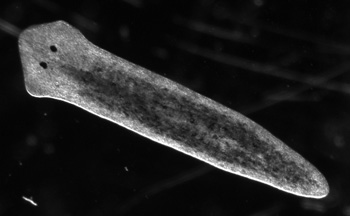Flatworms Could Replace Mammals for Some Toxicology Tests
July 1, 2015
By Kim McDonald

Freshwater planarians are small, inexpensive, easy to breed, sensitive to chemicals in the water and develop within a week.
UC San Diego
Laboratories that test chemicals for neurological toxicity could reduce their use of laboratory mice and rats by replacing these animal models with tiny aquatic flatworms known as freshwater planarians.
Scientists at UC San Diego have discovered that planarians, commonly used in high-school biology labs to study regeneration and the primitive nervous system, are actually quite sophisticated when it comes to modeling the response of the developing human nervous system to potentially toxic chemicals.
The researchers published their findings in the current issue of the journalToxicological Sciences.
"Because planarians have unique features such as a brain of intermediate complexity, a short regeneration time and offer the possibility of studying adults and developing worms in parallel, they make a good complementary system to existing animal models for studying developmental neurotoxicity," said Eva-Maria Schoetz Collins, an assistant professor of biology and physics who headed the research group. "Using such alternative animal models will not only reduce costs, but will also significantly reduce the number of laboratory mammals used in toxicology tests."
Humans are faced with thousands of potentially toxic compounds in their environment and new chemicals are added daily in the products we use, from pesticides to cosmetics to food additives. How to test these new chemicals for their safety has become a growing problem, given that traditional toxicology testing has long relied on laboratory rodents. Now, efforts are being made to replace them with alternatives that employ cultured cells or alternative animal models, such as zebrafish, that permit researchers to screen thousands of potential toxins more quickly and at a reduced cost.
"In recent years, several government agencies have begun to work together in what is called the 'Tox21 Initiative,' with the goal of changing the way toxicology testing has been done through in vitro assays such as cultured cells and alternatives to laboratory rodents," explained Schoetz Collins. "Because each testing platform, be it an animal model or in vitro assay, has its limitations, it is important to perform tests across several platforms to determine the toxic concentrations and mechanisms of action for the development of reliable exposure guidelines for humans."
Schoetz Collins and her collaborators began their study when they noticed that the planarians they were using in their laboratory experiments were particularly sensitive to different environmental conditions.
As an experiment, they developed a five-step semi-automatic screening platform to characterize the toxicity of nine known "neurotoxicants"—consisting of commonly used solvents, pesticides and detergents—and a neutral agent, glucose, on a species of planaria called Dugesia japonica. The researchers then quantified the effects of the various compounds on the planarians' viability, stimulated and unstimulated behavior, regeneration and brain structure.
"Comparisons of our findings with other alternative toxicology animal models, namely zebrafish larvae and nematodes, demonstrated that planarians are comparably sensitive to the tested chemicals," the scientists concluded in their paper.
"Like zebrafish and nematodes, freshwater planarians are small, inexpensive and easy to breed, sensitive to chemicals in the water and develop quickly," in approximately one week, the researchers added.
But planarians also have important advantages to these alternative animal models.
"What renders freshwater planarians unique and particularly well-suited for developmental neurotoxicology is our ability to simultaneously study genetically identical adult and developing animals, allowing us to directly compare the effect of potential toxicants on the adult and developing brain, without possible complications from the variability of genetic factors," the scientists wrote.
In addition, they added that the planarian nervous system is much more complex than that of nematodes, but simpler than that of zebrafish, and shares "the same neuronal subpopulations and neurotransmitters as the mammalian brain, to be relevant to human studies. In fact, the planarian brain is thought to be more similar to the vertebrate brain than to other invertebrate brains in terms of structure and function."
Schoetz Collins emphasized that while her group's research study demonstrates the viability of freshwater planarians as an alternative animal model for neurotoxicity, the aquatic flatworms won't replace laboratory rodents, but will instead limit their use.
"Mammalian models will still be necessary," she added, "but pre-screening with different models will allow us to select a smaller number of toxicants to be tested in mammals, thus reducing their use to the strict minimum."
Other UC San Diego researchers involved in the study were Danielle Hagstrom, Olivier Cochet-Escartin, Siqi Zhang and Cindy Khuu.
Their paper in Toxicological Sciences is referenced at doi: 10.1093/toxsci/kfv129. The project was supported by grants from the National Institutes of Health (5T32GM007240-37), Hellman Foundation, Burroughs Wellcome Fund and Alfred P. Sloan Foundation.
Media Contact: Kim McDonald, 858-534-7572, [email protected]
